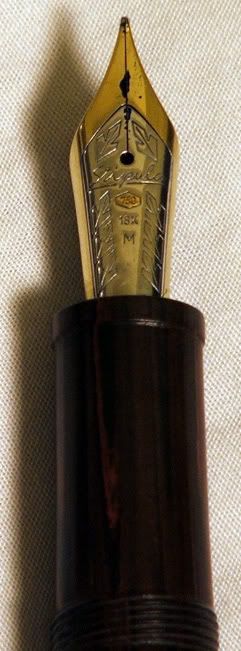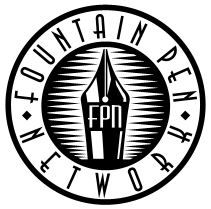I will be very honest; I was not expecting much from this pen. I was burned on the Stipula 22 and a few Stipula/Levenger Verona fountain pens. They were plagued with extremely poor ink flow, problems with the ol nib skipping and using feeds that were either too small for the nibs or just straight up flawed!!!
I saw this pen on the http://www.pens-more.com/ website under the Stipula section and for some odd reason I was attracted to it. It had the red/black wood grain style and at the time I had no clue what the pen was made out of. I had a few Stipula postcards and there was one on there that looked identical to the one that was for sale. I asked Travis (the owner) about the pen but he told me that he really didn’t know too much about it but he did like it. He said that the pen has not moved so he was reducing the price by a few dollars. There was no box or papers, which accounts for the low price. He said the pen was only dipped to inspect the nib but it was never filled.
I was pretty excited to see how this pen looks and writes, the pictures on the website really didn’t do the pen justice.
Appearance/ Finish 5 out of 5
Alrighty then, let’s get down to business!!! When the pen arrived, I knew it was definitely ebonite with the silver cap band and clip, the one that I was looking at on the Stipula Postcard. The silver was a bit tarnished and the ebonite looked a bit dull from what the picture looked like. I looked the underside of the nib and you could tell where the nib was dipped. There was some dried ink and some crud between the feed and the nib.

What to do what to do??? First thing I did was polish the nib with a tad bit of alcohol on a cotton swab to get rid of the dried up ink. I was very careful not to put alcohol on the feed or on the rest of the pen. Surprisingly there was a good amount of gunk within the engravings on the nib and the nib practically glowed after just a tad bit of wiping. The next thing I did was run water through the piston filler to clean that out. To my surprise, there were no signs of ink in the piston chamber so Travis was right; this pen was never filled, only dipped.
The next thing on the agenda was to polish up the clip and cap band. I used some Simichrome polish and carefully applied it to the clip and bands, I made sure none of the polish made it on the ebonite; I didn’t want to see what would happen!!! J I used a nice soft cloth to rub out the tarnish that was on the silver parts. Within a minute or so of doing this, the dull silver started to really shine. After I finished that, I used a pipe polishing cloth that I had on hand because I do occasionally smoke my pipes and I have developed a very nice collection over the years. Look at me, it sounds like I am 70 years old, I’m only 33, anyways lets get back to the story. Wimg, our lovely MAD DUTCHMAN gave me advice, since this is my first ebonite pen I was a bit unsure how to care for this material. I gently wiped the pen down for a few minutes, making sure I got every nook and cranny on this pen. Once I was done, I used a soft clean cloth and gently rubbed and massaged the pen down until it started to really shine and come alive. Before polishing, the pen had a bit of a cloudy appearance, now it is cleared up, shiny and now you could see the detail.

This is now a pen that has been brought to its former glory. This pen is a red and black wood grain design with the pen being made out of ebonite. It really looks like a classic pen from the 20’s and 30’s. The cap band and clip are of a wonderful silver material that shined up with ease and. This is really a gorgeous looking pen.
Design/Size/Weight 5 out of 5
Well the Novecento is shaped similarly to the Bexley 10th Anniversary fountain pen. The cap tassie is not a typical flat top, it gradually had a minor round shape to it. The dimensions of the pen capped are approximately 5 3/8 inches by 1 ¾ inches and with the pen posted, it is roughly a bit more than 6 ½ inches long.

The weight of this pen is about 1.3 OZ making this an average weight pen. I have no issues posting the cap on this pen. The pen is extremely well balanced and I wrote extensively with this pen and have yet had tired cramping fingers and hands. Without the cap posted, the pen seems to have good balance and it conforms to the web of the hand between the thumb and index finger.
Surprisingly I observed little to no slip of fingers while gripping the pen when you are writing. The threads are not metal on either the section or on the inside of the cap. The pen tightens and loosens without any issues. I see that one needs to be cautious in screwing and unscrewing the cap. Over time I see the threads stripping due to the fact that the threads on the section are on the shallow side. As long as you exercise care while using you pen. I really do not see this as a problem. Most of you all exercise care with your fountain pens due to the cost of these writing instruments. So this probably wont be a problem BUT it should be something you should monitor.
The clip uses a spring loaded mechanism, so there are no worries about damaging the clip if you are using heavier clothing. There is a good amount of range with this clip, allowing the ability to clip this pen to just about anything. The tension is firm but not tight which makes this a user friendly clip and I see this giving you many years of writing enjoyment.

Nib Design and Performance 5 out of 5
The nib on this particular pen is an 18kt gold two tone with a medium width to it. If you have never seen this nib then look below, It has engravings on both the left and right side of the nib that resembles straw. Here is the story on the word and meaning of Stipula, this might give you a better insight of the definition. I stolen this text from www.madeinfirenze.it
STIPULA - the meaning of the name
The name “Stipula” boasts very ancient origins. In the Latin language it literally meant “straw” or “small piece of straw”. But the actual meaning of the word is connected to the widespread use, among the ancient Romans, of stipulating an agreement by splitting a small piece of straw. For us, this name indicts a deep commitment for quality and accuracy, a special agreement made with those who hunt for excellence and indisputable quality in writing instruments.

Now that you are all enlightened and stuff the rest of the nib has the word “Stipula” in cursive. Below the Stipula text there is what looks like a diamond with “750” in gold. Below that is “18K” and last but not least is “M” for the nib being a medium.
The nib was a tad bit on the scratchy side, so I had to realign the tines and then I polished the nib to include flossing the tines with a Mylar smoothing disc that is 1.5 microns to get the rough edges down and then finishing it off with the .1 micron disc to polish the insides of the tines along with the tipping material on the nib.
After about 30 minutes of meticulous work, this pen was writing as smooth as ice that has been rode over by a Zamboni. I was very surprised with how well this nib wrote, well, actually glided across my paper. I experienced ZERO ink feed issues with this pen. Considering I have had nothing but problems with the past Stipulas I owned, this one wrote flawless and was a pleasure to use.

Yes, I ate crow!!! I vowed never to buy another Stipula as long as I lived. Well, that lasted all of about 7 months. I bet Wimg is licking his chops and laughing as a Mad Dutchman would!!!
This nib wrote with a nice juicy medium line. This is what kind of nibs I like, nice wet writers that flow like a river. As I said, I am very impressed with this nib; this is something that I was not expecting at all. I was looking at some of the other Novecento models and they have 14kt gold nibs rather than the 18kt this ones has. Maybe there is a reason because this is the ebonite version as there are acrylic resin models that have the 14kt nibs. I am not an authority on Stipula pens, which is Wimg’s thing, not mine.
The Filling System 5 out of 5
OHHHYEAHHH, this baby is a piston filler!!! This pen has my full blessing!! The piston chamber holds a good amount of ink and it seems to hold it with perfect pressure. The placement of the piston knob is at a typical location, at the rear end of the barrel. There is a thin silver ring right before the piston knob. They did a very good job with placing the piston knob flush with the ring and barrel because you really cannot tell that it is a knob. Bravo Stipula, Bravo!!!
Cost 5 out of 5
This is the best part of the review because of the price that I paid for it. This pen was priced at around the $80.00 mark. I couldn’t pass this pen up at all. This was the only reason why I bought this pen in the first place was because the price. The pen needed about less than an hour of some TLC and then I was rewarded with a pen that exceeded any expectation that I have ever had. Brand new Novecento Ebonite with the box, papers and what not is around $280.00 if you can find it. I was looking at the http://www.giardino.it/ website and they stated that these are no longer in production. I guess I lucked out!!!

Conclusion
I guess an old dog can learn new tricks and same goes for an old Savage. I was blown away with such a killer pen for such a rock bottom price; I am still in awe to this day. Would I spend $280.00 on this pen, honestly, NO WAY! But used for half the price or more?? Most certainly, without a shadow of a doubt I would. This really brought me back into taking a second look at Stipula pens. I pretty much wrote them off for good until I saw this pen for sale on www.pens-more.com at a massive discount. Since then, I bought another Stipula pen off of the Pentrace Green Board. I will do a thorough review on that pen in an upcoming pen review on both my site and FPN. So in conclusion, this is a fantastic pen and if you are willing to spend the cash, I am sure you will be very happy with it. Just imagine how much happier you would be by getting this pen for around $80.00!!!

No comments:
Post a Comment